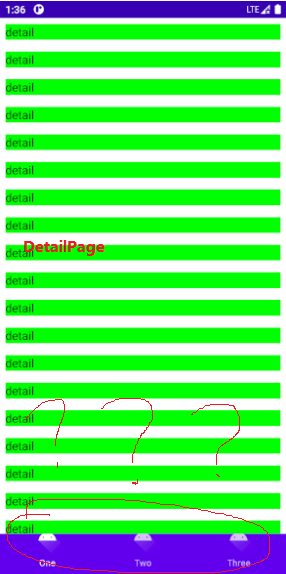做主頁導航時會用到底部導航欄,Jetpack Compose提供了基礎槽位的佈局Scaffold,使用Scaffold可以構建底部導航欄,例如:
@Composable
fun Greeting(vm: VM) {
val list = listOf("One", "Two", "Three")
var selectedItem = remember {
mutableStateOf(0)
}
val navController = rememberNavController()
Scaffold(bottomBar = {
state.takeIf { it.value }?.let {
BottomNavigation {
list.forEachIndexed { index, label ->
BottomNavigationItem(
label = { Text(text = label) },
selected = index == selectedItem.value,
onClick = { selectedItem.value = index },
icon = {
Icon(
painter = painterResource(id = R.drawable.ic_launcher_foreground),
contentDescription = null
)
})
}
}
}
}) {
NavHost(navController = navController, startDestination = "one") {
composable(route = "one") { PageList(navController, vm) }
composable(route = "detail") { PageDetail(vm) }
}
}
}

這是一個最簡單的Scaffold,其主頁時PageList,顯示一列數字,點選數字後會跳轉到PageDetail頁面。
但是有個很大的問題,就是在跳轉到PageDetail頁面之後,BottomNavigation並沒有隨之消失,於是乎出現了這樣一個奇怪的現象:

為了解決這個問題,可以採用State去控制BottomNavigation的可見性,並將其儲存在ViewModel中。
具體做法是:
1.在ViewModel中建立一個包含Boolean值的LiveData變數state。當state為true時繪製BottomNavigation,為false時不繪製
2.在包含Scaffold頁面中監聽state,並控制BottomNavigation的可見性。
3.在PageList(也就是Scaffold導航的主頁)進入時設定state為true、退出時設定state為false
// ViewModel
class VM: ViewModel() {
private val _state: MutableLiveData<Boolean> = MutableLiveData(true)
val state: LiveData<Boolean> get() = _state
fun setState(status: Boolean) {
_state.postValue(status)
}
}
// MainPage
@Compose MainPage(vm: VM) {
LaunchedEffect(key1 = true) {
vm.setState(true)
}
DisposableEffect(key1 = true) {
onDispose {
vm.setState(false)
}
}
}
// page contains Scaffold
@Composable
fun Greeting(vm: VM) {
// State of BottomNavigation`s visibility
val state = remember { mutableStateOf<Boolean>(true) }
// read the BottomNavigation`s visibility from ViewModel and send to State
vm.state.observeAsState().value?.let { state.value = it }
Scaffold(bottomBar = {
// show / hide BottomNavigation controlled by State
state.takeIf { it.value }?.let {
BottomNavigation {
list.forEachIndexed { index, label ->
BottomNavigationItem(
label = { Text(text = label) },
selected = index == selectedItem.value,
onClick = { selectedItem.value = index },
icon = {
Icon(
painter = painterResource(id = R.drawable.ic_launcher_foreground),
contentDescription = null
)
})
}
}
}
}) {
NavHost(navController = navController, startDestination = "one") {
composable(route = "one") { PageList(navController, vm) }
composable(route = "detail") { PageDetail(vm) }
}
}
}
這種做法的好處是簡單,侵入性低,無需修改系統api也無需自定義view。缺點就是麻煩,需要在導航中的每個主頁都進行設定。
我在StackOverflow上提問時有人回答了另一個辦法。這個辦法是給每個螢幕新增標誌位,來區分是否是導航的主頁,之後再建立BottomNavigation時進行判斷。貼一下:
You need to specify which screens you want to show and which screens you dont want; Otherwise it will show to all the screens inside Scaffold's body (which you have bottomBar). The code below was from my app.
Create a state which observes any destination changes on the navController
Inside when you can put any screens that you want to show navigationBar else just set currentScreen to NoBottomBar
@Composable
private fun NavController.currentScreen(): State<MainSubScreen> {
val currentScreen = remember { mutableStateOf<MainSubScreen>(MainSubScreen.Home) }
DisposableEffect(key1 = this) {
val listener = NavController.OnDestinationChangedListener { _, destination, _ ->
when {
destination.hierarchy.any { it.route == MainSubScreen.Home.route } -> {
currentScreen.value = MainSubScreen.Home
} else -> currentScreen.value = MainSubScreen.NoBottomBar
}
}
addOnDestinationChangedListener(listener)
}
return currentScreen
}
On the Scaffold where you put ur bottomBar
so you can check if currentScreen was NoBottomBar if it was, don't show it
// initialized currentScreeen above
val currentScreen by navController.currentScreen()
Scaffold(
bottomBar = {
if (currentScreen != MainSubScreen.NoBottomBar) {
MainBottomNavigation()
} else Unit
}
) {
// Your screen
}